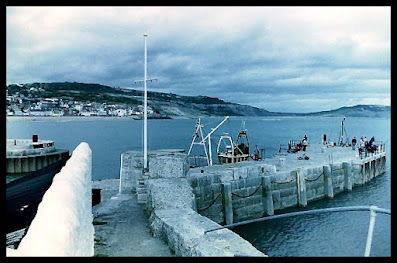Mentioned in the 1086 Domesday Book, Lyme developed into a major port by the 13th century. The addition of Regis to the town name was due to Royal Charter granted by King Edward in 1284, and was later confirmed by Queen Elizabeth I in 1591. The development of Lyme as a major port and shipbuilding centre was mainly because the artificial harbour, known as the Cobb, acts as a protection from storms.
Existing since at least 1313, the earliest construction consisted of an infilling of large boulders held in place by oak piles driven into the sea bed, in a basic shape similar to how it is now. The Cobb at that time was not connected to the mainland however, and it wasn't until 1756 that a causeway was built. The present walls date from 1824, when it was rebuilt after being breached by storms.
In the photo above, the 'Gin Shop' can just about be seen set into the wall with steps either side at the point where the wall curves to the left. Don't get too excited though, as it doesn't sell alcohol drinks but is a former ammunition store holding the ball and powder for the cannon which were used to defend the Cobb. Its name derives from the hoist lift which was once set above the store. Sorry to disappoint! ;)
There was at one time a cement factory further west along the beach, and the old wooden posts set into the sand in this corner of the harbour are the remains of a horse-drawn truck railway that ran between the two, presumably for loading on and off the ships.
The High Wall continues out into the bay behind the central Cobb buildings. The wall once extended further out but was lost during the severe storms and was never rebuilt. However, the foundations can still be seen at low tide.
The buildings date from around 1723 and have variously been used as a warehouse, an isolation hospital and a yacht club. They are now used partly for fishermens stores and the Marine Aquarium.
Two wonderful connections with the Cobb involve literary characters by the well known authors Jane Austen and John Fowles. Jane Austen visited Lyme and set part of her book 'Persuasion' here, taking many local names for the names of her characters. One of her heroines, Louisa Musgrove, insisted on being 'jumped down' from the Cobb steps by one of the heroes. Wanting a second 'go', she ran back up the steps and jumped before he was ready, falling badly in the process, whereupon she was 'taken up lifeless' to a nearby house to recover.
John Fowles's character was the melancholic and enigmatic Sarah Woodruff from 'The French Lieutenant's Woman', who often stood at the end of the Cobb staring out to sea, supposedly mourning the loss of her French lover who left and disgraced her. The film of the same name was set in Lyme and the Cobb was used as well as the Undercliff which runs between Lyme Regis and Axmouth in Devon.
There is so much history attached to the Cobb, that I've only put in the few snippets that I find personally interesting. The photos were taken at various times. The b&w photos were taken circa 1991, when I was braver then than now, and I was able to walk along the wall. The blue ones were taken in 2009. The prints came out garish and almost unscannable, but when I obtained a neg scanner I found that the negatives were mostly cyan and that the printer had added the colours during the printing stage. I stopped using that printer afterwards, although I must admit I love the effect of these particular photos. And the final views of the Cobb from the gardens were taken in early 2011.
Outside the Marine Aquarium sits this wonderful piece of driftwood upon a crab pot. Queue the music to the film 'Jaws'...
Finally, the overall view below. I'll see if I can explain it.
On
the right the Cobb swerves out from the mainland. The High Wall is
carried on the right side of that and continues in a lazy S shape out
into the bay, affording wonderful views for those who wish to tread the
footsteps of the 'French Lieutenant's Woman'. The central piece contains
buildings which now hosts the Marine Aquarium, the left arm of which is
the Victoria Pier used by fishing boats and anglers. The left side is
the North Wall with a gap between the sea end and the rest of the Cobb
(called Crab Head), enabling boats to navigate in and out of the
harbour.
Lyme Regis is such a fabulous little town with lots of interesting buildings and loads of history. Well worth a visit if possible. :)












No comments:
Post a Comment